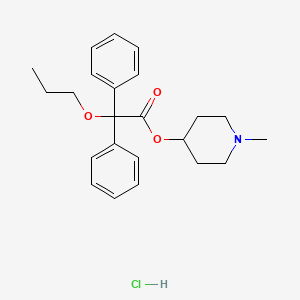

Synopsis
Synopsis
0
USDMF
0
CEP/COS
0
NDC API
0
VMF
0
FDA Orange Book

0
Australia

DRUG PRODUCT COMPOSITIONS
0
US Patents
0
US Exclusivities
0
Health Canada Patents
0
Data Compilation #PharmaFlow
0
Stock Recap #PipelineProspector
0
Weekly News Recap #Phispers
0
News #PharmaBuzz


1. Alpha-diphenyl Alpha-n-propoxyacetic Acid-4(1-methylpiperidyl)ester
2. Detrunorm
3. Mictonetten
4. Propiverin
5. Propiverine
6. Propiverine Hydrochloride
1. Propiverine Hydrochloride
2. 54556-98-8
3. Mictonetten
4. Propiverine (hydrochloride)
5. Propiverine Hcl
6. 1-methyl-4-piperidyl Diphenylpropoxyacetate Hydrochloride
7. Nsc-172140
8. Propiverine Hydrochloride [jan]
9. (1-methylpiperidin-4-yl) 2,2-diphenyl-2-propoxyacetate;hydrochloride
10. Dsstox_cid_26847
11. Dsstox_rid_81957
12. Dsstox_gsid_46847
13. Detrunorm
14. Dc4gzd10h3
15. Cas-54556-98-8
16. Ncgc00181103-01
17. P-4
18. Mictonorm (tn)
19. Propiverin Hydrochloride
20. (1-methylpiperidin-4-yl) 2,2-diphenyl-2-propoxyacetate Hydrochloride
21. Bup-4 (tn)
22. Chebi:8494
23. Schembl1034248
24. Chembl2359059
25. Dtxsid1046847
26. Propiverine Hydrochloride (jp17)
27. Bcp09576
28. Tox21_112719
29. Nsc172140
30. S4931
31. Propiverine Hydrochloride [mi]
32. Akos015962920
33. Tox21_112719_1
34. Ac-2076
35. Ac-8718
36. Ccg-268683
37. Hy-116408a
38. Ncgc00181103-02
39. Propiverine Hydrochloride [who-dd]
40. Db-015754
41. Cs-0091435
42. Ft-0656926
43. D01007
44. Q27276325
45. (1-methylpiperidin-4-yl)2,2-diphenyl-2-propoxyacetate Hydrochloride
46. (1-methyl-3,4,5,6-tetrahydro-2h-pyridin-4-yl)2,2-diphenyl-2-propoxy Acetate Hcl
47. (1-methyl-3,4,5,6-tetrahydro-2h-pyridin-4-yl) 2,2-diphenyl-2-propoxy Acetate Hydrochloride
| Molecular Weight | 403.9 g/mol |
|---|---|
| Molecular Formula | C23H30ClNO3 |
| Hydrogen Bond Donor Count | 1 |
| Hydrogen Bond Acceptor Count | 4 |
| Rotatable Bond Count | 8 |
| Exact Mass | 403.1914215 g/mol |
| Monoisotopic Mass | 403.1914215 g/mol |
| Topological Polar Surface Area | 38.8 Ų |
| Heavy Atom Count | 28 |
| Formal Charge | 0 |
| Complexity | 429 |
| Isotope Atom Count | 0 |
| Defined Atom Stereocenter Count | 0 |
| Undefined Atom Stereocenter Count | 0 |
| Defined Bond Stereocenter Count | 0 |
| Undefined Bond Stereocenter Count | 0 |
| Covalently Bonded Unit Count | 2 |
Urological Agents
Drugs used in the treatment of urological conditions and diseases such as URINARY INCONTINENCE and URINARY TRACT INFECTIONS. (See all compounds classified as Urological Agents.)
Muscarinic Antagonists
Drugs that bind to but do not activate MUSCARINIC RECEPTORS, thereby blocking the actions of endogenous ACETYLCHOLINE or exogenous agonists. Muscarinic antagonists have widespread effects including actions on the iris and ciliary muscle of the eye, the heart and blood vessels, secretions of the respiratory tract, GI system, and salivary glands, GI motility, urinary bladder tone, and the central nervous system. (See all compounds classified as Muscarinic Antagonists.)
Parasympatholytics
Agents that inhibit the actions of the parasympathetic nervous system. The major group of drugs used therapeutically for this purpose is the MUSCARINIC ANTAGONISTS. (See all compounds classified as Parasympatholytics.)
Global Sales Information

Market Place

REF. STANDARDS & IMPURITIES

ANALYTICAL

ABOUT THIS PAGE


LOOKING FOR A SUPPLIER?
